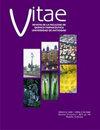Vascular interactions of Croton schiedeanus major flavonoids in isolated aortic rings from Wistar rats
Q3 Pharmacology, Toxicology and Pharmaceutics
引用次数: 2
Abstract
Background: Ayanin (3,7,4’-Tri-O-methylquercetin) and 3,7-Di-O-methylquercetin (DMQ) are the main active metabolites isolated by bioguided fractionation from Croton schiedeanus, species known popularly in Colombia as “almizclillo”, which has been studied in experimental models in rats, exerting vasodilator and antihypertensive effects. Also, when the effect of these flavonoids was studied separately, important vasodilation was observed. Objective: To evaluate whether flavonoids from Croton schiedeanus have synergistic vasodilator properties when different combinations are used in isolated aorta rings. Methods: Cumulative concentrations of ayanin (10-8 M - 6x10-5 M or 0.01 μM - 60 μM) were assayed in the absence and presence of an increasing concentration of 3,7-Di-O-methylquercetin (DMQ) (10-8 – 3x10-5 M or 0.01–30 μM) in isolated rings from Wistar rats, pre-contracted with phenylephrine. The concentration-response curve with the maximal effect was compared with that obtained by Croton schiedeanus whole ethanolic extract (10-6 – 3x10-4 g/mL). Also, this combination was assayed in the presence of the nitric oxide synthetase inhibitor L-NAME (10-4 M) and the guanylate cyclase inhibitor methylene blue (10-4 M) to assess the role of the NO/cGMP pathway in this interaction. Results: Ayanin and DMQ display a dual interaction in vascular relaxant response: agonism at higher concentration ranges (10-6 – 3x10-5 M or 1–30 μM) and antagonism at lower concentration ranges (10-8 – 3x10-7 M or 0.01–0.3 μM). The efficacy at the highest concentration was greater than that obtained by the whole extract (Emax: 98.4% vs. 33.9%). This response was decreased but not reverted in the presence of L-NAME and methylene blue. Thus, the vasodilator effect of this combination does not depend entirely on the NO/cGMP cyclic pathway. Conclusion: The combined use of appropriate concentrations of these flavonoids could represent an advantage over Croton schiedeanus whole extract for vasodilator purposes.巴豆主要黄酮在Wistar大鼠离体主动脉环中的血管相互作用
背景:Ayanin(3,7,4′-三- o -甲基槲皮素)和3,7-二- o -甲基槲皮素(DMQ)是通过生物引导分离从Croton schiedeanus(哥伦比亚称为“almizclillo”)中分离得到的主要活性代谢产物,在大鼠实验模型中进行了研究,具有血管扩张和降压作用。此外,当这些类黄酮单独研究时,观察到重要的血管舒张作用。目的:评价巴豆黄酮在离体主动脉环中不同组合是否具有增效扩张性。方法:用苯肾上腺素预收缩Wistar大鼠离体环,在不存在3,7-二- o -甲基槲皮素(DMQ) (10-8 - 3 × 10-5 M或0.01 μM - 60 μM)的情况下,测定紫花鸟苷(10-8 M - 6 × 10-5 M或0.01 μM - 60 μM)的累积浓度。将效果最佳的浓度-响应曲线与巴豆全乙醇提取物(10-6 - 3 × 10-4 g/mL)的浓度-响应曲线进行比较。此外,在一氧化氮合成酶抑制剂L-NAME (10-4 M)和鸟苷酸环化酶抑制剂亚甲基蓝(10-4 M)存在的情况下,对这种组合进行了分析,以评估NO/cGMP途径在这种相互作用中的作用。结果:紫花苋苷和DMQ在血管舒张反应中表现出双重相互作用:在较高浓度范围(10-6 - 3x10-5 M或1-30 μM)具有激动作用,在较低浓度范围(10-8 - 3x10-7 M或0.01-0.3 μM)具有拮抗作用。最高浓度下的效果优于全提取物(Emax: 98.4% vs. 33.9%)。在L-NAME和亚甲基蓝的存在下,这种反应减弱,但没有恢复。因此,这种组合的血管扩张作用并不完全依赖于NO/cGMP循环途径。结论:适当浓度的黄酮类化合物联合使用比巴豆全提取物具有更强的血管舒张作用。
本文章由计算机程序翻译,如有差异,请以英文原文为准。
求助全文
约1分钟内获得全文
求助全文
来源期刊

Vitae
PHARMACOLOGY & PHARMACY-
CiteScore
1.20
自引率
0.00%
发文量
0
审稿时长
>12 weeks
期刊介绍:
The journal VITAE is the four-monthly official publication of the School of Pharmaceutical and Food Sciences, and its mission is the diffusion of the scientific and investigative knowledge in the various fields of pharmaceutical and food research, and their related industries. The Journal VITAE is an open-access journal that publishes original and unpublished manuscripts, which are selected by the Editorial Board and then peer-reviewed. The editorial pages express the opinion of the Faculty regarding the various topics of interest. The judgments, opinions, and points of view expressed in the published articles are the responsibility of their authors.
 求助内容:
求助内容: 应助结果提醒方式:
应助结果提醒方式:


